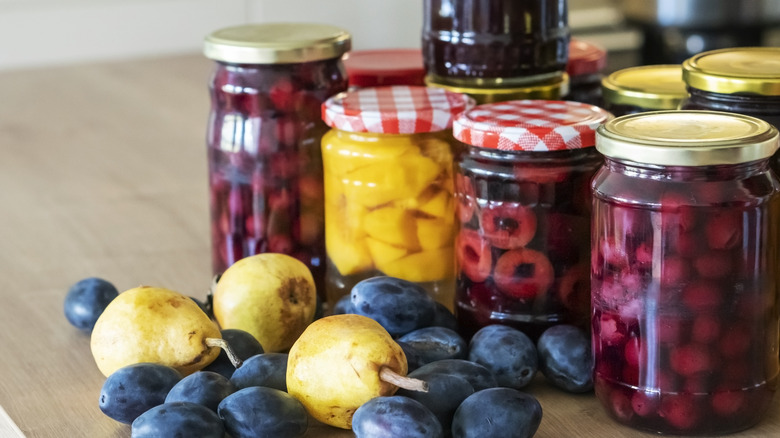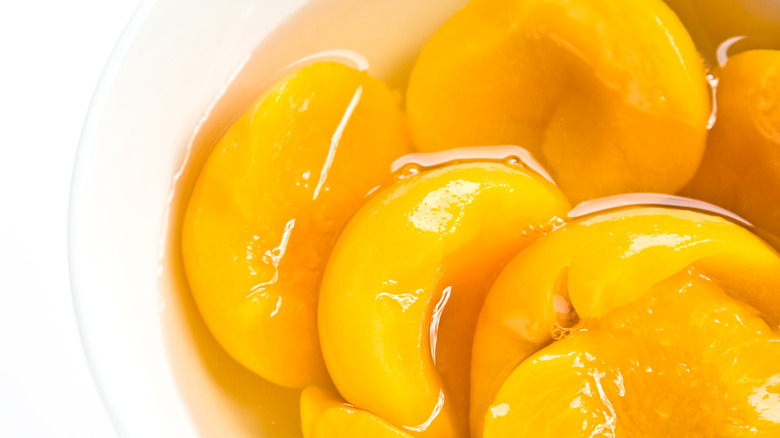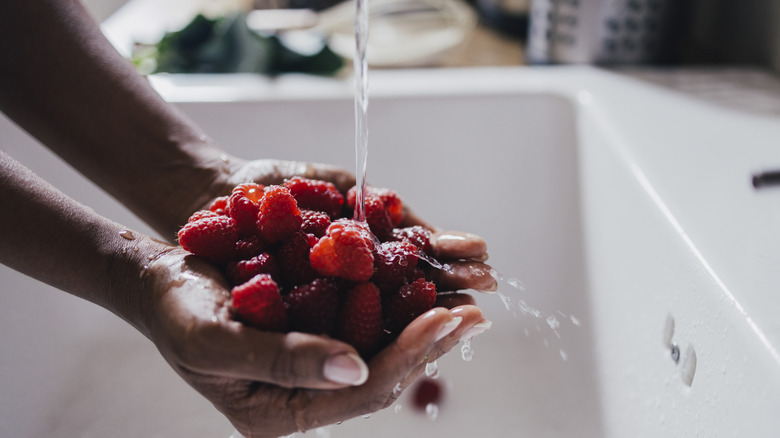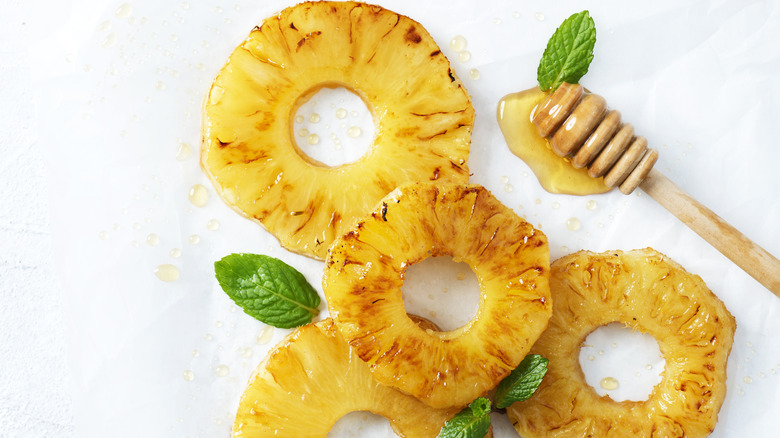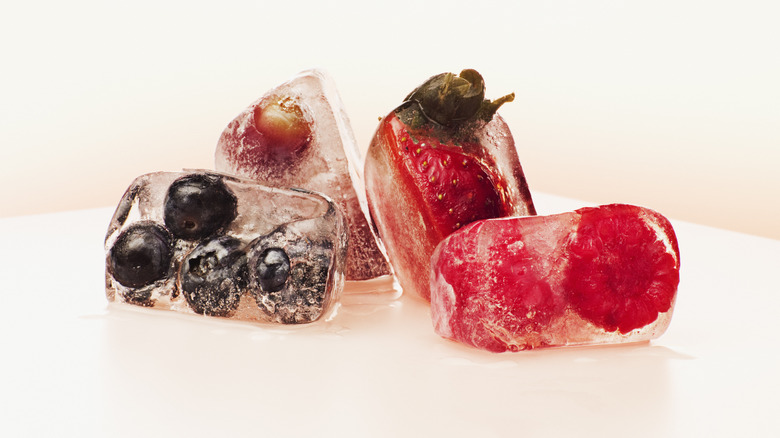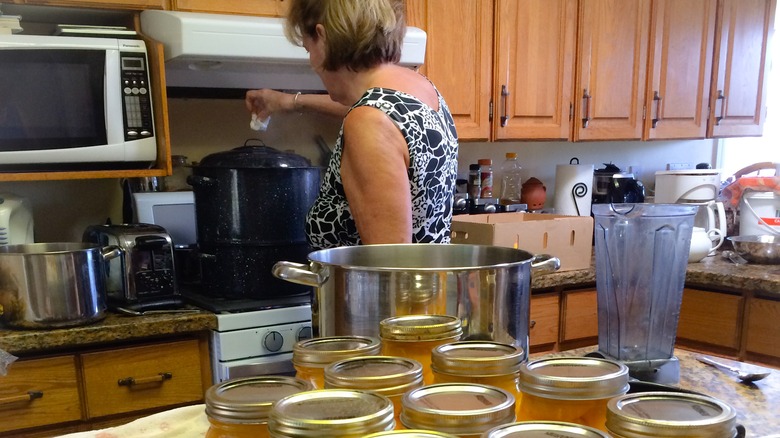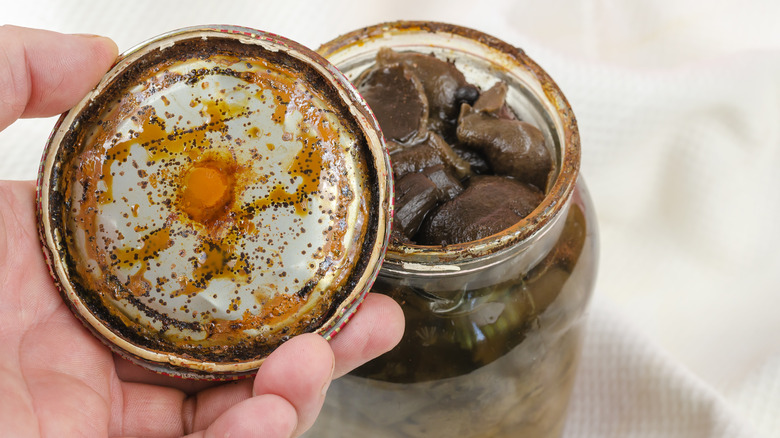12 Mistakes Everyone Makes With Canned Fruit
We may receive a commission on purchases made from links.
While canned fruit seems to harbor a bad reputation for being an unhealthy option, it turns out that in many cases, this notoriety is unfounded. You can rest assured that canned fruits are indeed considered healthy. Because the fruit is processed at peak ripeness and often within hours of harvest, canned produce maintains the same — if not more — nutritional value as fresh when it comes to vitamins and key nutrients. In a country where many are not including the appropriate amount of fruit as a part of their daily diet, this makes things like pineapple, pears, peaches, or tomatoes packaged for later consumption a viable, more affordable option for families, college students, and chefs alike.
That being said, we want to be sure we are using those juicy preserved goods to their full potential, and the truth is, many of us aren't. Here are some common mistakes consumers make when it comes to purchasing, using, and discarding canned fruit.
1. Using fruit soaked in heavy syrup
While the level of vitamin C in a piece of fresh fruit tends to diminish over a few days sitting on a counter or riding to its new destination in the back of a delivery truck, canning will keep that same piece of fruit's level the same. This makes it a great option for your pantry as far as longevity goes, but all canned fruits are not created equal. It is those packed in water, or in their own juices, that take the nutritional first prize, while those packed in heavy syrup finish last.
A can of standard-sized Del Monte peaches packed in heavy syrup comes in at a whopping 100 calories and 21 grams of total sugar (including 14 grams of added sugar) per 1/2 cup serving. This is staggering when compared with the label on the back of the same product of the same brand packed in water, which measures in at 35 calories per serving and only 7 grams of sugar — none of which are added.
If fruits soaked in syrup are your only options, light syrup is better than heavy; but opting for fruit in water or natural juices is the best practice.
2. Not rinsing the fruit off
While canned fruit chunks, halves, and slices will inevitably absorb some sugar from the cloyingly sweet liquid they are sitting in, rinsing can make a big difference when it comes to removing some of that excess treacly fluid which will still be clinging to the outside of the fruit itself. Just as the same trick lowers the sodium of canned beans and vegetables, rinsing your canned fruits can reduce their sugar content. This is especially true for the ones packaged in heavy syrup, which, just like cookies, cakes, flavored yogurts, sodas, and juices, include a lot of added sugar.
According to the CDC, the average person (man, woman, teen or child) in America consumes about 17 teaspoons of added sugar per day, totaling around 270 calories. Given that added sugar is associated with a myriad of health problems like obesity, diabetes, and heart disease, among others, it's important to take action where we can in preventing the amount we put into our bodies. When it comes to indulging in canned fruits, something as simple as a strainer and a stream of water can do this for us — making enjoying this sweet treat a much healthier, guilt-free experience.
3. Not baking with canned fruit
Think you can't whip up that delicious peach cobbler for your family gathering because it's the wrong season? Think again. With the USDA bestowing a best-quality shelf life of 12-18 months on high-acid canned items like fruits and tomatoes, that means that when you can't find the fresh produce you need sitting in the aisles of your favorite grocery store, that can of preserved peaches waiting in the dark corner of your cabinet can save the day. And the best part? Even if those peaches have been sitting there longer than that, they are generally still usable. While the overall quality of a can past its best-by date may have declined some, as long as there are zero signs of spoilage, it is perfectly safe to bake into that dessert.
Different approaches may have to be taken into account when baking with fresh fruit versus canned, of course. Canned fruits tend to be sweeter due to the syrup and juice they might absorb, so bakers should prepare their taste buds accordingly. Some recipes might recommend adjusting your baking time, brushing the crust of a pie with egg whites to prevent sogginess, or throwing some cornstarch into your fruit filling to help it thicken, but one thing's for sure; with canned fruit on your side, you can still make a mean cobbler, regardless of the season.
4. Not spicing it up
While there may be a bit of nostalgia for the old-school lunches when opening up a cup of diced pineapple chunks, we'll be the first to admit that canned fruits, while sweet and often refreshing, can be pretty one-note in terms of taste. Thankfully, there are many creative ways to spice things up — literally.
Cinnamon, for starters, could be stirred in with canned apples or peaches to give them a burst of tasty and metabolism-boosting flavor. The classic lime juice and chili powder combination could be sprinkled on a bowl of mangoes for an unexpected, anti-inflammatory kick. Or how about trying some vitamin-packed basil sprinkled on some preserved strawberries?
Along with being outright delicious and flavor-enhancing, both herbs and spices have been found to be powerhouses of health benefits. From protecting against chronic illnesses to lowering glucose and cholesterol to being a major source of antioxidants, the use of seasonings like turmeric, cardamom, or rosemary could very well enhance your quality of life. Why not slip a pinch into your dietary regimen wherever you can — including a dusting on top of your favorite canned fruit?
5. Not buying store can brands
When it comes to saving money on the grocery bill every month, there are a plethora of recommendations floating around out there. Pragmatic options such as using coupons, developing a list ahead of time, or having a meal plan outlined for the week exist right alongside tips more psychological in nature, like not walking into the store hungry or shopping on the least busy day of the week. But perhaps the most guaranteed way to save money on groceries is by buying generic brands.
Target with Market Pantry, Costco with Kirkland, Walmart with Great Value; so many hypermarkets now offer their own store brand food items. Because of the lack of traditional marketing costs, they are usually able to sell their private-label products at a much lower price point than the name brand ones sitting on their shelves ... and canned fruits are no different.
Take two cans of mandarin oranges on an aisle in Target, for instance. One Del Monte 15-ounce can costs $2.49, while its counterpart, a 15-ounce can of mandarin oranges from Market Pantry (Target's brand) goes for $1.49. That's an entire dollar difference — and you can imagine how that can add up quickly! Given that generic brand canned fruits read almost exactly the same label-wise as their name-brand competitors, you don't stand to lose much going with store brand for your next can of grapefruit. From a financial standpoint, at least, you stand to gain. Your wallet will thank you!
6. Tossing expired cans into the trash
If you're uncomfortable using a can of fruit that has passed its "best-by" date, that's totally fine. What's not totally fine? Throwing it away! Most food banks will gladly accept food that is past its prime. The New York City Food Policy Center points out that some larger organizations will have the resources — sometimes in the form of a registered dietician on staff — to help ensure all food that is donated is still safe for consumption and distribution. This means that can of fruit cocktail you'll never use could go a long way for someone in need.
However, it is true that not all food banks will take past-date foods, especially smaller establishments. If this is the case where you live and you've exhausted all donation possibilities, disposing of the can may be your only option. If so, you should never throw away an expired can full. Opening up the can first, discarding the fruit and juices separately, and then recycling the metal container is the most environmentally-friendly way to go in this scenario.
7. Keeping leftovers too long in the fridge
While a sealed can of fruit might be able to last a few years on a shelf, once it's opened, it loses that seemingly magical ability. We're sure we aren't the only ones that have ever picked up a half-empty can from where it was tucked away in the recesses of the refrigerator for who-knows how long and thought, "It's good, right?" Turns out, it's probably not. The USDA outlines that high-acid canned foods like fruit should only be stored five to seven days before being discarded in the waste bin. Low-acid canned products such as meat, fish, or potatoes are given an even shorter allowance — three to four days, max.
Leftovers should also be transferred out of the can and into a plastic or glass container for storage. This will maintain better flavor as well as eliminate any risk for can corrosion, a process in which metals from opened cans containing acidic foods actually begin to leach into the foods themselves. Don't worry too much, though. The latter, while possible, is uncommon and not a significant cause for concern. To be safe, though, let's keep the leftovers in a fresh storage container and out of the fridge entirely after a week, shall we?
8. Not grilling with canned fruit
Had you ever considered that a can of pineapple slices could be thrown onto your grill and made into a delicious side during your next cookout? We didn't think so. Although you may have never thought about it, it is entirely possible (and entirely delicious) to grill or roast canned fruit. Doing so can enhance the flavor, just as it would with fresh fruit.
Since canned fruits are soft in consistency, the key to success is to drain them and then pat them dry before attempting to grill or roast them to remove excess wetness and avoid any sogginess that might occur. Once that step is done, season to your liking and crank up the heat! Try experimenting with oven-roasted peaches drizzled in maple syrup, or a pinch of brown sugar sprinkled on top of canned pineapple rings before browning them on the hot surface of a grate. Using heat to create a bit of char on the otherwise one-dimensional surface of soft canned fruits can add an interesting and welcome note of texture, making for a delicious, unexpected crowd-pleaser during your next barbecue party.
9. Not freezing canned fruit
While canned fruit leftovers can be stored in the fridge, you've only got about seven days to use them up before the quality starts to diminish and you are forced to toss them. However, there exists a way to extend their life a bit further that most never consider; if you don't think you'll use that last half can of berries by the time it reaches its end, consider freezing it.
Preserving canned fruit leftovers in the freezer that you would have otherwise thrown away is a fantastic way to avoid food waste. Feeding America reports that every year in the United States, 119 billion pounds of food is wasted. It's a staggering number and equates to roughly 40% of food in the U.S. going in the trash Before you head for the trash can with those few-days-old pears, consider placing them in an airtight bag or glass container and clearing a space for them in your freezer for later use.
Bear in mind that canned fruit is already mushy in texture, and therefore will be doubly so when defrosted. But this makes it perfectly suited to be thrown in a smoothie in the summertime, turned into a puree for homemade baby food, or form the base of a sauce. Whatever you decide to do with your frozen delectables, we can almost certainly assure you it will be better than condemning them to a trash bag, and ultimately a landfill.
10. Not exploring its full range of uses
Have you ever thought to drop a few canned strawberries into your crispy rice cereal, or stir some mixed berries into your bowl of morning oatmeal? Ever whipped up a compote to top your english muffin using canned peaches, honey, and some thickener? What about using the leftover juice in that cup of mandarin oranges to sweeten a sauce for your next barbecue sandwich instead of simply dumping it down the garbage disposal?
A little creative thinking — or perhaps some resourceful Googling — can open you up to a whole new world of possibilities when it comes to using the canned fruits in your pantry. There's no need to eat them the same way you have been forever when recipes abound for bright salads, refreshing popsicles, swirled yogurt parfaits ... and even leftover-juice cocktails! Who knows? As you expand your canned fruit horizons, you might just find any previous misplaced notions about these sweet, preserved gems vanishing, too.
11. Not making your own
If you grow your own food, you've probably once or twice experienced having a really, really good year. Out of the blue, an apple tree or a blueberry bush in your backyard explodes with ripe, juicy fruit. While you're certainly stoked for this stroke of good gardening luck, you know deep down there's only so many pies, pancakes and compotes you can make before your taste buds begin to tire. What to do when you know you'll never get through every single berry or apricot before that healthy, happy fruit starts to turn to mush? If you've already given your family, friends and coworkers bags of peaches and still have a considerable pile collecting dust on your kitchen counter, it might be worth considering canning them for later.
Canning fruit in your very own home might sound like an intimidating and expensive endeavor, but the truth is, the only things you really need to get started are the cans themselves, a large pot, and a canning rack — many of which go for about $20 on Amazon. A pricier item, such as a pressure canner, is not necessary in the case of canning fruits because they are high-acid foods. While you would need to invest in a pressure canner to have success with lower acid foods, such as vegetables or meats, fruit is a whole other, simpler ball game.
12. Avoiding canned fruit completely
Some people may be wary of eating canned fruit due to a fear of botulism, a rare but potentially deadly form of food poisoning that can wiggle its way into some canned food products. However, according to the National Center for Home Food Preservation, it is not canned fruits you need to be worried about. Fruit is considered to be a high-acid food, and the acidic environment provided by a cozy can of peaches, for example, will naturally kill any botulism spores that might try and develop within. It is the low-acid foods (things with a ph level higher than 4.6) like meat, seafood, and vegetables that warrant caution, because they do not contain in and of themselves the necessary acid needed to kill off these spores.
There are a few fruits that fall outside of this category, however. Tomatoes, which have sometimes been found to contain a ph level slightly higher than 4.6, and figs, which have a ph level just a hair higher than what can be considered safe. When canning these two items, although they are technically fruits, they must be treated as a low-acid food for safety purposes and acidified with lemon juice or citric acid.
